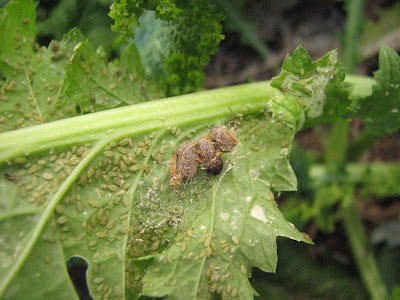One very effective way to eliminate a pest is to eliminate its food. If you starve any creature to death long enough it shouldn’t come back – right? That is what many people in Tucson choose to do if they receive repeated assaults from Squash Vine Borers. That does not necessarily take care of the pests though, as the pest may come back the next season you plant a crop. Another option is to grow indoors. However, the cost is too great for most gardeners to pay for the lighting and fancy equipment needed to grow crops in a controlled environment such as a greenhouse, nor do most gardeners want the possible consequences that could occur if whiteflies or some other insect pest happened to sneak into a controlled growing area. Instead, most gardeners prefer to work in rich soil and do what they can to keep bugs from taking the majority of their veggies.
 |
| A good read for Southwestern Gardeners |
In order to control the bug problem in my garden I practice a form of Integrated Pest Management, or IPM for short, in order to maintain the health of my vegetable garden. In Desert Gardening for Beginners by Cromell, the author devotes an entire chapter (7 pages) to managing insects. She describes the 6 steps of Integrated Pest Management as follows:
1. Identify the pest
2. Monitor the pest’s population levels.
3. Decide how much damage is acceptable to you (for the plant’s health and/or aesthetics).
4. Consider all options, including no control at all.
5. Keep accurate records
6. Evaluate results and modify the program as needed.
Although I will not expound too much on these points, the author does, and I would highly suggest a read of this little book for those seeking to grow veggies in the Southwest. I am very good at each of these steps except for step 5. The only time I wish I had kept better records for pest control would be to determine when the beginning and end of the Squash Vine Borer season is. Integrated Pest Management works for me because, even though I tend to notice a lot, I am a very lazy gardener. I do not want to spray my crops nor deal with the effects of a chemical spray. Instead I could do some of the following:
- Choose to use some low-impact techniques, including the use of beneficial insects.
- I could spray my garden with some form of home-made concoction (such as with garlic or with hot pepper).
- I could spray with the area with BT bacteria.
- I could dust all affected plants with Dichotomous earth (which kills insects that walk on it).
- Practice some form of crop rotation to decrese the reoccurance of a yearly pest infestation.
- Kill the plants and let the ground fallow for a while.
I have tried making a homemade spray before and it works a little. However, most concoctions only work for while and do not get at the heart of the problem. I have used Dichotomous earth in the past, and I feel it works well for cutworms, but I resist using it in any place frequented by lizards or beneficial bugs. For the most part I choose to fallow one of my two gardens and use beneficial insects, both of which are free techniques. This helps me to do as little maintainence on my pests as possible. Though I do hope to grow cover crops in my fallowed garden in the future, for now my fallowed area seconds as a compost pile.
 |
| Dichotomous Earth can be bought from Hardware Stores |



































